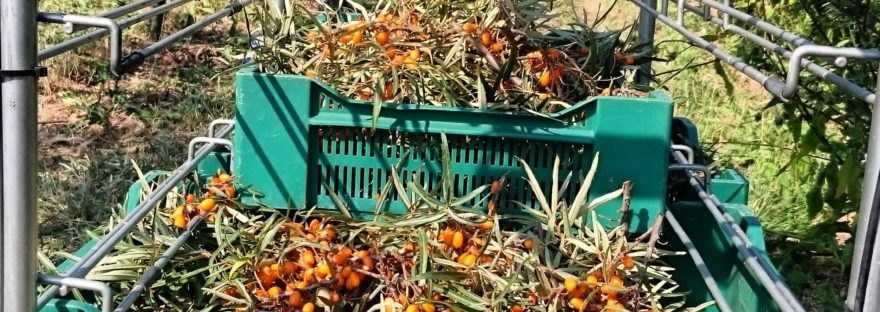Harvest 2017 showed great prospect for our sea buckthorn. All the Siberian plants across the site produced heavy – predicted yields of berries. Having produced a crop the next challenge was to create an efficient, affordable means of harvesting. Winter 2017/18 therefore focused on delivering this process.
One can formulate the best plans but in agriculture there are natural variables that have the capacity to undermine concept based on theory. We all have experiences of weather and the seasons but these now have to blend with considerations as to the impact of a changing climate and how much to risk manage this position.
We still have mild winters. I am told that the severe weather incident in mid-March should be taken as a one in fifty year event. Its impact disrupted the pollination of our sea buckthorn resulting in no Siberian crop, although we still have a yield of Latvian and German varieties. The climate might be changing but unless this is repeated within the next three years, we have to discount this as a novel event.
The prolonged period of hot, dry weather over June and July is a different matter. This has been predicted by climate change scientists and it seems to be repeated across the globe. We need to look at our sea buckthorn crop and assess the impact of this phenomenon.
After a solid two months of no rain and temperatures up to the mid-30 deg C has left the majority of the plants still looking healthy. As our soil is clay and our water table is high plants have a capacity to reach down for water. This does not mean that all plants are healthy. These conditions create stress and there are possible 15% of the plants shedding leaves and looking very sad.
Our investment in a Ladurna cultivator this year must have helped in both reducing weed competition, but also combining that weed growth back into the soil around the plant. The use of compost to improve organic matter in the soil is an on-going concept to improve the health of the soil and potentially improve its moisture retention. We will be using a combination of wood chip and green waste compost this autumn to keep this process going. The ability to combine it into the top tilth with the Ladurna will hopefully increase the incorporation and benefit process.
Irrigation is an option. It is my personal belief that if we are going to see more long hot summers then the plants have to work harder, their roots need to go deeper and the soil needs to retain more available moisture. Irrigation will be useful in establishing plants in their first two years, but as a tool for yield enhancement I am personally not convinced that there is benefit.
This year our Augustina were irrigated every two days to see if the few berries there were might improve in size. Unfortunately there seemed to be no response. A more technical approach might be worthwhile with a nutrient irrigation package but strictly on a trial basis. As we have limited capital investment available this can probably be better focused elsewhere.
Investment capital is a precious resource and this year it has been channelled into developing a facility to mechanically harvest our crop. The fact the crop has been tiny has strangely been a real advantage. The development of any new system takes time to plan, but it is the practical implementation that reveals the real issues.
The harvest processing site we have built from a collection of two refrigerated lorry bodies, two large portacabins and five containers. The temporary nature of the site is with an intent to develop harvesting/processing ideas from concept to full development on a small, low cost scale that can then be moved into a new building once we fully understand what we need. The site will comply with food hygiene regulations and this will also cover how we operate in the field as well as within the buildings.
We started harvesting our Latvian berries a week ago and each day the process has been refined. The process requires the cutting of branches and them being brought back to the site for freezing in a new cold store. The cold store temperature is set at running down to -24 deg C, with a concept of wanting to freeze the berries as fast as possible. We have found that with an ambient temperature in the 30s, simple issues such as loading branches into the cold store requires skill to prevent the store temperature from rising and compromising its ability to blast freezer the incoming crop.
The newly designed berry separator has arrived and is being operated in a chill room at temperatures of between 2-5 deg C. The machine is designed for this, but as a prototype it will require on-going improvement to create the ideal machine for the job.
We are already looking to a redesign of the linkage between the cold store and chill room to ensure a consistent working cold temperature. We have been told that we are a low risk operation in terms of food hygiene management, but even so maintaining high standards is our target and each practical step requires refinement to achieve the right level of practical approach.
It is this transition of working to create an efficient, workable harvesting system that is taking time. If we had had a heavy crop this process of developing the harvesting system on the job would have been challenging.
But as it is, by next year we will have created a mechanically assisted harvesting process that will accommodate the crop that we had in 2017. That is farming for you. Each year is a new year, which is what makes the job worthwhile.

